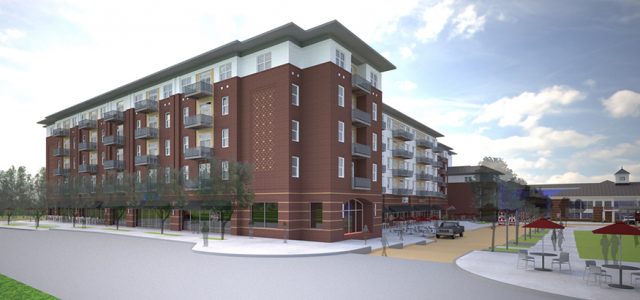Mississippi State University plans to build a trigeneration microgrid — combined cooling, heating and power — at its new College View student residential-retail building and campus development project outside Starkville.

*Photo provided by Mississippi State University, Greystar Real Estate Partners
Project partners anticipate that the microgrid will save $116,000 annually or $2.9 million over the microgrid’s 25-year energy services agreement at no upfront cost to the university. The partners include developer Blue Sky Power, Mississippi State and Greystar Real Estate Partners.
The microgrid will combine natural gas-fired CHP and a new, centralized chilling and heating system.
“The MSU Clean Energy Microgrid will operate in parallel with the grid, as well as island from the grid during power outages to provide safe, clean and resilient energy,” James Carskadon from Mississippi State’s Office of Public Affairs told Microgrid Knowledge. “The system is sized to cover the campus’s baseload power needs, as well as 100 percent of emergency power demand to keep critical loads operating in an outage. On some temperate blue sky days, the microgrid will provide all of the power for the campus, and on most days, the campus will use power from the microgrid and the utility.”
Mississippi State’s trigeneration microgrid
Construction of the residential-retail complex began in March. Slated for completion in August 2019, Phase I of the project spans 46,000 square feet and includes 656 residential beds. Recreational facilities, an outdoor entertainment zone, a 7,000 square-foot addition to the university’s daycare center and parking are also to be built.
Mississippi State, Greystar and Blue Sky Power executives met early in College View‘s development planning process to discuss ways to use distributed, clean energy to realize multiple benefits. Blue Sky Power worked with Philadelphia’s Burns Engineering, the university, Greystar, College View lead engineers from Corbett Legge & Associates in Tupelo, Mississippi and local utility Starkville Utilities to come up with the idea and design and engineer the College View microgrid, Carskadon explained.
“It was imperative to design the system to cover the emergency loads that would have been covered by back-up generators that were being replaced by the College View Clean Energy Microgrid,” Carskadon said.
The centralized trigeneration system, central boiler and chiller plant configuration make it cost-effective to replace the decentralized systems — heating, cooling and diesel generators — in the original design plan. That created more in the way of apartment and retail space.
Producing and distributing electricity on-site will yield a substantial proportion of the overall savings project partners expect to realize from the microgrid, Carskadon said. In addition, the College View campus is new construction, so the determination to switch from decentralized hot water heating and cooling systems created significant savings by reducing operating costs and replacing equipment with a shorter useful life. That decision also enabled the design team to remove heat pumps and cooling equipment from the original roof design and switch to a pitched roof, he said in an interview.
Project designers considered installing a solar photovoltaic generation system in the microgrid on College View’s clubhouse. The lack of a viable market for solar renewable energy credits in Mississippi, as well as having to modify the design of rooftops, led the team to discard the idea, Karskadon said.
Long term sustainability and energy savings
Greystar works closely with Mississippi State in managing the university’s real estate holdings. The real estate development and property manager is developing the microgrid as per the terms of a 40-year lease of university land that comes with a 10-year option to renew.
Greystar is a longer term client of Blue Sky Power, which works with real estate investment trusts, senior-living communities and municipalities to design, finance and implement energy and sustainability projects and programs across the US. Blue Sky and Greystar have been studying Greystar’s national collegiate housing portfolio with an eye towards identifying opportunities to realize energy savings by boosting properties energy efficiency, reliability and resiliency, while at the same time minimizing carbon and environmental footprints.
The College View microgrid is part of Mississippi State’s long-term sustainability plan. In line with the university’s sustainability goals, the microgrid will enhance campus energy resiliency and security, as well as reduce carbon and greenhouse emissions. The project will eliminate some 750 metric tons of carbon dioxide annually — 18,750 tons over 25 years. That’s the equivalent of the amount of carbon a 22,085-acre forest would store each year, according to Greystar Vice President of University Partnerships’ Mark Grambergs.
Trigeneration microgrid at-a-glance
-
Capacity: 285 kW (2,337,000 kWh)
-
Cooling: 100T (100T x 8200HRS)
-
Heating Output: 1,450,000 BTU/H (11,890,000,000 annually)
All new construction on Mississippi State’s Montecito campus, where the College View project is located, is carried out with sustainability at the forefront of project design, construction and performance. The university is saving an average of nearly $1 million a year in energy and maintenance costs as a result of having completed an energy-efficient lighting retrofit project, for example.
Over the longer term, the university has realized more than $55 million in savings as a result of its energy efficiency and sustainability efforts at Montecito since fiscal 2006, according to the university. Earlier this month, the Tennessee Valley Authority recognized MSU with a carbon reduction award for the university’s low carbon emissions.
Track news about cogeneration and trigeneration microgrids. Subscribe to the free Microgrid Knowledge newsletter.


